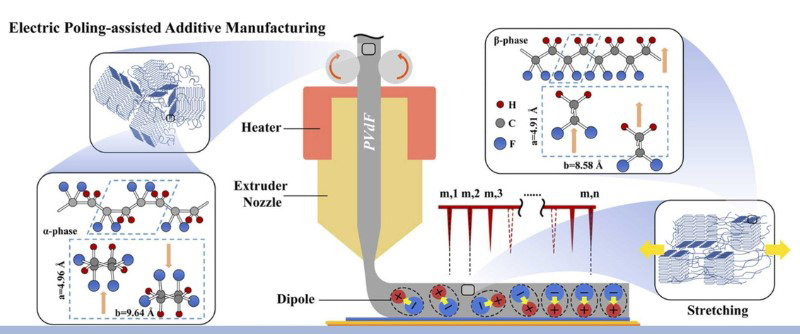April 17, 2023
Purdue researchers combine electric poling and 3D printing into a single step

Purdue University researchers have combined 3D printing and electric poling into a single process called electric poling-assisted additive manufacturing, or EPAM. It aligns the dipoles in PVdf filament during the printing, which leads to a better indication of the stress being applied. (Purdue University image/Robert Nawrocki)
Method creates parts with customized shapes and sensor properties
WEST LAFAYETTE, Ind. – Manufacturers of smart medical devices, smart robots and other products with smart sensors could simplify their device design and fabrication using a patent-pending Purdue University method that combines piezoelectric poling of filament and 3D printing in a single process.
Traditional sensor materials have piezoelectric properties that make them suitable to create smart sensors. Applying stress in one direction produces voltage in another direction. Although these materials measure how much stress is applied, which is among the basic properties of sensors, they cannot be used in 3D printing.
3D printing, also known as additive manufacturing, has several advantages over traditional manufacturing, including customizing parts’ shapes and geometries beyond planar options. However, the polyvinylidene difluoride (PVdf) filament used in 3D printing doesn’t have strong piezoelectric properties. Its dipoles are randomly oriented, which produces less voltage. As a result, traditional PVdf filament isn’t a good indicator of stress, and electric poling must be conducted in a post-processing treatment, increasing time and cost.
Purdue researchers in the Purdue Polytechnic Institute have combined 3D printing and electric poling into a single process called electric poling-assisted additive manufacturing, or EPAM. It aligns the dipoles in PVdf filament during the print, which leads to a better indication of stress that is being applied. This allows 3D-printed parts to have both strong sensing abilities and customized shapes. Importantly, it saves time and money.
Robert Nawrocki, assistant professor in the School of Engineering Technology in the Purdue Polytechnic Institute, said the EPAM process accomplishes stretching and poling simultaneously, which are necessary conditions for the polarization.
“During the EPAM process, stretching the molten PVdF rod rearranges the amorphous strands in the film plane, and the applied electric field aligns dipoles toward the same direction,” Nawrocki said. “The EPAM process can print free-form PVdF structures and induce the formation of β-phase, which is primarily responsible for the piezoelectric response.”
Jose M. Garcia-Bravo and Brittany Newell, associate professors of in the School of Engineering Technology, Nawrocki and PhD candidate Jinsheng Fan successfully printed PVdf force sensors with a fused deposition modeling 3D printer with a corona electric poling setup.
“The piezoelectric activity, measured in picocoulombs per newton, or pC/N, was calculated based on the piezoelectric output voltage,” Nawrocki said. “The average piezoelectric activity of EPAM-printed PVdF films was 47.76 pC/N, or about five times higher than unpoled 3D-printed films, at 9.0 pC/N. The piezoelectric activity of unpoled 3D-printed PVdF films indicated that 3D printing in the absence of an electric field did not result in dipole alignment.”
Nawrocki disclosed the innovation to the Purdue Research Foundation Office of Technology Commercialization, which has applied for patent protection on the intellectual property. Industry partners interested in further developing the technology should contact Dhananjay Sewak, dsewak@prf.org, about 2022-NAWR-69857.
The next steps to commercialize the EPAM method are to build a single 3D printing machine that can print all of the sensor components, including live-poled PVdF, electrodes and also the structure.
The research was published in the July 2022 issue of Advanced Engineering Materials and the December 2022 issue of Additive Manufacturing. Nawrocki and the research team received funding and other support from Purdue University.
About Purdue University
Purdue University is a top public research institution developing practical solutions to today’s toughest challenges. Ranked in each of the last five years as one of the 10 Most Innovative universities in the United States by U.S. News & World Report, Purdue delivers world-changing research and out-of-this-world discovery. Committed to hands-on and online, real-world learning, Purdue offers a transformative education to all. Committed to affordability and accessibility, Purdue has frozen tuition and most fees at 2012-13 levels, enabling more students than ever to graduate debt-free. See how Purdue never stops in the persistent pursuit of the next giant leap at https://stories.purdue.edu.
About Purdue Research Foundation Office of Technology Commercialization
The Purdue Research Foundation Office of Technology Commercialization operates one of the most comprehensive technology transfer programs among leading research universities in the U.S. Services provided by this office support the economic development initiatives of Purdue University and benefit the university’s academic activities through commercializing, licensing and protecting Purdue intellectual property. In fiscal year 2021, the office reported 159 deals finalized with 236 technologies signed, 394 disclosures received and 187 issued U.S. patents. The office is managed by the Purdue Research Foundation, which received the 2019 Innovation and Economic Prosperity Universities Award for Place from the Association of Public and Land-grant Universities. In 2020, IPWatchdog Institute ranked Purdue third nationally in startup creation and in the top 20 for patents. The Purdue Research Foundation is a private, nonprofit foundation created to advance the mission of Purdue University. Contact otcip@prf.org for more information.
Writer: Steve Martin, sgmartin@prf.org
Media contact: Robert Nawrocki, rnawroc@purdue.edu

